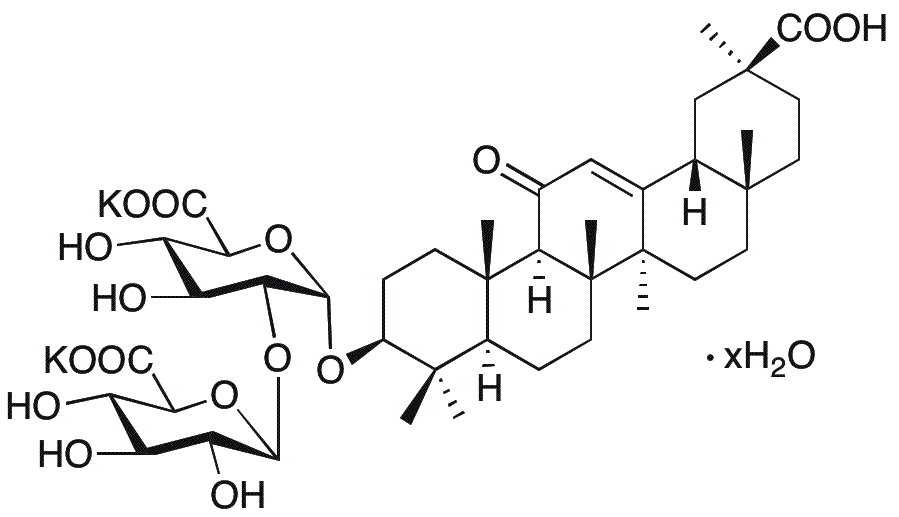Dipotassium glycyrrhizinate hydrate is widely utilized in research focused on
- Cosmetics: This compound is often used in skincare products for its anti-inflammatory and soothing properties, making it effective in reducing redness and irritation in sensitive skin.
- Pharmaceuticals: It serves as a natural sweetener and flavor enhancer in various medicinal formulations, improving patient compliance, especially in pediatric and geriatric populations.
- Food Industry: As a food additive, it is employed for its sweetening capabilities, providing a natural alternative to synthetic sweeteners, which can be beneficial for health-conscious consumers.
- Anti-allergic Treatments: The compound is researched for its potential in treating allergic reactions due to its ability to inhibit histamine release, offering a natural approach to allergy management.
- Anti-cancer Research: Preliminary studies suggest that it may have anti-tumor properties, making it a subject of interest in cancer research for developing new therapeutic strategies.
General Information
Properties
Safety and Regulations
Applications
Dipotassium glycyrrhizinate hydrate is widely utilized in research focused on
- Cosmetics: This compound is often used in skincare products for its anti-inflammatory and soothing properties, making it effective in reducing redness and irritation in sensitive skin.
- Pharmaceuticals: It serves as a natural sweetener and flavor enhancer in various medicinal formulations, improving patient compliance, especially in pediatric and geriatric populations.
- Food Industry: As a food additive, it is employed for its sweetening capabilities, providing a natural alternative to synthetic sweeteners, which can be beneficial for health-conscious consumers.
- Anti-allergic Treatments: The compound is researched for its potential in treating allergic reactions due to its ability to inhibit histamine release, offering a natural approach to allergy management.
- Anti-cancer Research: Preliminary studies suggest that it may have anti-tumor properties, making it a subject of interest in cancer research for developing new therapeutic strategies.
Documents
Safety Data Sheets (SDS)
The SDS provides comprehensive safety information on handling, storage, and disposal of the product.
Product Specification (PS)
The PS provides a comprehensive breakdown of the product’s properties, including chemical composition, physical state, purity, and storage requirements. It also details acceptable quality ranges and the product's intended applications.
Certificates of Analysis (COA)
Search for Certificates of Analysis (COA) by entering the products Lot Number. Lot and Batch Numbers can be found on a product’s label following the words ‘Lot’ or ‘Batch’.
Número de catálogo
Número de lote/lote
Certificates Of Origin (COO)
This COO confirms the country where the product was manufactured, and also details the materials and components used in it and whether it is derived from natural, synthetic, or other specific sources. This certificate may be required for customs, trade, and regulatory compliance.
Número de catálogo
Número de lote/lote
Safety Data Sheets (SDS)
The SDS provides comprehensive safety information on handling, storage, and disposal of the product.
DownloadProduct Specification (PS)
The PS provides a comprehensive breakdown of the product’s properties, including chemical composition, physical state, purity, and storage requirements. It also details acceptable quality ranges and the product's intended applications.
DownloadCertificates of Analysis (COA)
Search for Certificates of Analysis (COA) by entering the products Lot Number. Lot and Batch Numbers can be found on a product’s label following the words ‘Lot’ or ‘Batch’.
Número de catálogo
Número de lote/lote
Certificates Of Origin (COO)
This COO confirms the country where the product was manufactured, and also details the materials and components used in it and whether it is derived from natural, synthetic, or other specific sources. This certificate may be required for customs, trade, and regulatory compliance.


